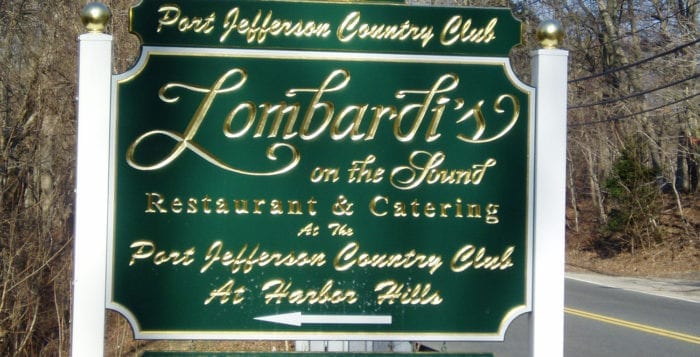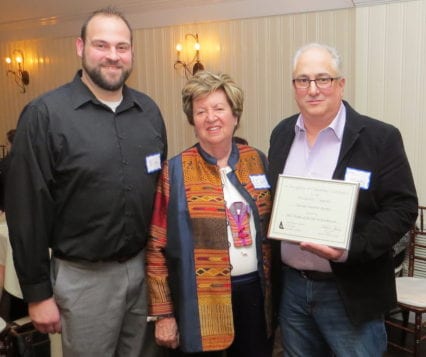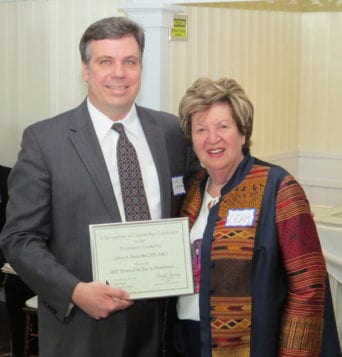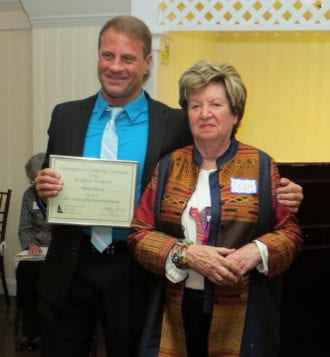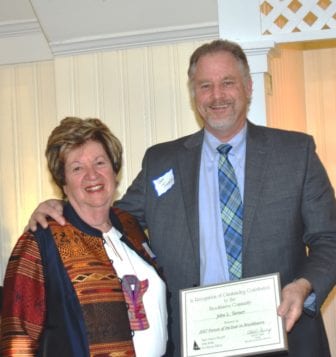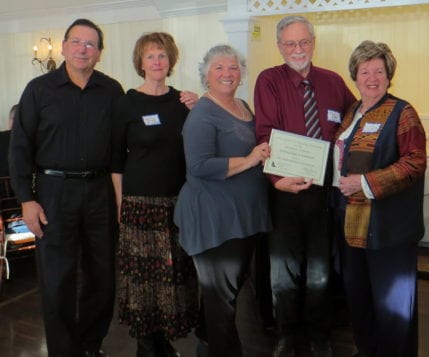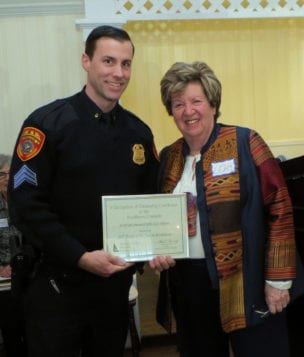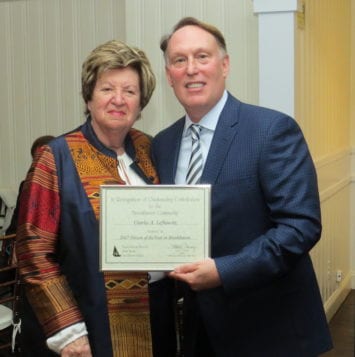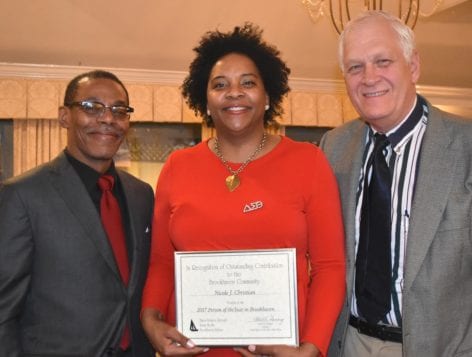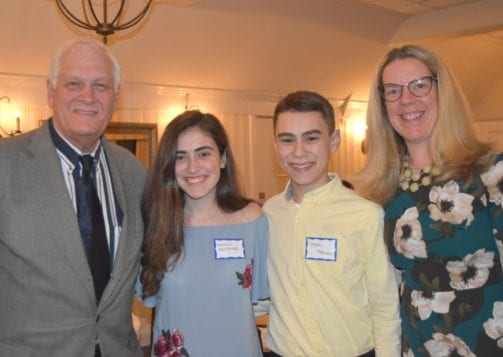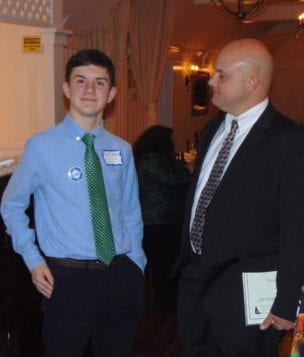The national walkout planned for March 14 came and went in Port Jefferson, and students stayed indoors. However kids from both Port Jefferson and Comsewogue school districts didn’t sit out of the gun control conversation playing out across the United States.
As discussions of a national movement sprung up in early March calling for students across the United States to at once exit school buildings beginning at 10 a.m. as a form of protest in response to the shooting that killed 17 people in Florida in February, administrators across the North Shore grappled with the idea of allowing students to demonstrate without punishment and the possible dangers associated with walking out of school.
Officials from both districts elected to schedule indoor assemblies to discuss school violence and gun control, encouraging students not to physically walkout of buildings.
“We want students who choose to be involved to have a focus for their efforts, so the day and time will be meaningful,” Port Jeff Superintendent Paul Casciano said ahead of plans being finalized.
What eventually unfolded in Port Jeff, after collaboration between administration and students, was an assembly in the auditorium open to all students, in which victims of the shooting were honored, and then attendees were given the opportunity to deliver remarks that were approved by the administration prior to the event, according to students Gavin Barrett and Matt Pifko. The pair are among a group of students who both operate @pjhswalkout, an Instagram account which has served to organize those in the district interested in becoming more organized and vocal on gun control and overall school safety, and also participated in collaborating on the March 14 events with school officials, including Principal Christine Austen.
March For Our Lives to take place in PJS
By Alex Petroski
In accordance with the call to action issued by survivors of the mass school shooting in Parkland, Florida, a local March For Our Lives rally will take place in Port Jefferson Station at the intersection of Routes 112 and 347 March 24 from 1 to 3:30 p.m., according to representatives from the activists North Country Peace Group.
Students and families from Marjory Stoneman Douglas High School and others worldwide will take to the streets to demand action from elected officials to stem the escalation of gun violence and mass shootings in the nation’s schools. The Port Jefferson Station gathering is one of more than 650 events planned for that day.
The students and their parents are sponsoring the rally with help from The North Country Peace Group, Long Island Rising, Moms Demand Action for Gun Sense in America and Building Bridges in Brookhaven. Two of those groups, Building Bridges and Moms Demand, were formed specifically in response to gun shootings.
The organizers said all are welcome to attend the Port Jefferson Station rally. To participate in the program (priority will be given to students) or to learn more about the event, contact [email protected].
“I thought the assembly was a respectful balance of honoring the victims of the Parkland shooting and providing the students in attendance with an opportunity to bring awareness to the #Enough movement,” Austen said after the event.
Barrett and Pifko said the assembly had outcomes they viewed as both positive and negative, but overall applauded administration for its efforts in creating an environment in which students could express their views.
“I personally was able to share a lot of what I wanted to say,” Barrett said.
He added that an aspect of the planning was also to afford a platform to a friend with more conservative political leanings pertaining to gun control.
“Whatever people took away from our message, we were able to give them that freely and the school did let us speak freely on that front,” Pifko said. “We were able to inject political stances on it and genuine intent.”
The pair said they took issue with the conclusion of the assembly, which featured several faculty members reading an open letter purported to have been written by an educator that went viral on social media as news of a walkout swirled. The message of the letter was that rather than walking out of school, students should walk up to classmates viewed as outcasts in an effort to create a more inclusive school environment, a sentiment both students said they could get behind. But Barrett and Pifko said they weren’t aware the letter would be read, and while they could agree with the overall sentiment, they did not appreciate that the letter had a condescending tone, and included the line “Gun control or more laws is not, and will not, be the answer,” and felt the reading constituted faculty taking a political stand.
“The message of the letter was inclusivity; we want to encourage our students to make positive connections with one another in order to foster a welcoming school climate,” Austen said.
The students were clear to point out they don’t believe in tearing up the Second Amendment, but rather have a simpler political message and goal to their activism, which they said they plan to continue beyond the already-scheduled upcoming national demonstrations.
“We feel that students should be educated on the truth about gun legislation and gun control in a clear, concise and accurate manner,” Pifko said. “I think we educated people. We’re trying to create a discussion among peers.”
A station was also set up in the school where students were assisted in penning letters to members of Congress to express opinions on gun control. Barrett and Pifko said they also are trying to organize a group of students to travel to Manhattan March 24 to participate in New York’s version of March for Our Lives, a sister march to one taking place in Washington, D.C., the same day.
“One way or another these shootings have to stop,” Barrett said.
Ben Zaltsman, the school’s student body president, said he thought the assembly went perfectly and struck a good balance between memorial and political activism.
“I think the entire service was well balanced,” he said.
Comsewogue High School Principal Joe Coniglione and Deputy Superintendent Jennifer Quinn did not respond to questions asking what was being planned on the 14th or how the day played out after the fact, but Quinn said administration was working with students on an event.
Maddy Glass, a student at Comsewogue High School, said in a text message that like Port Jeff, students in Comsewogue were encouraged to participate in the district plans rather than exiting the building, which included an auditorium assembly. Glass and about 30 of her peers were granted permission by Coniglione to exit the assembly at 10 a.m. and head to the gymnasium, where students observed a moment of silence and made phone calls to the offices of local elected officials to voice their opinions on gun control.
“I felt like the assembly got to what we needed to in some places, but not the way we really needed,” Glass said. “A walkout would’ve brought everyone together in a different way, but since our ‘walkout’ to the gym was only about 30 of us it still felt like students were divided.”
She said she also realized administrators were in a difficult position in deciding how to handle the day, and appreciated the efforts made to allow students to express their opinions. Glass also said she hoped the outcome of increased activism amongst her peers would be Congress implementing actions to stop mass shootings.
“I’ve never been the type of kid who loved school, but I felt like I had some safety there, and with all of these school shootings and knowing people affected by them, I don’t feel as safe as I used to,” she said. “And I know I’m not the only one who feels that way.”












 ▶ The spring season will kick off with a special screening of “The China Hustle” at Theatre Three on March 19. The documentary exposes a new financial crime perpetrated by Wall Street where investors dumped their money into Chinese businesses that turned out to be fraudulent. The hook of the story is that everyone involved is guilty, including the investor who called out the fraud in the first place. Guest speakers will be Director Jed Rothstein by Skype and Juan Carlos Conesa, chair of Dept. of Economics, Stony Brook University.
▶ The spring season will kick off with a special screening of “The China Hustle” at Theatre Three on March 19. The documentary exposes a new financial crime perpetrated by Wall Street where investors dumped their money into Chinese businesses that turned out to be fraudulent. The hook of the story is that everyone involved is guilty, including the investor who called out the fraud in the first place. Guest speakers will be Director Jed Rothstein by Skype and Juan Carlos Conesa, chair of Dept. of Economics, Stony Brook University. ▶ “Sammy Davis, Jr: I’ve Gotta Be Me,” to be screened at the Long Island Museum on March 26, is the first major documentary to examine Davis’ vast talent and his journey for identity through the shifting tides of civil rights and racial progress in 20th century America. With interviews from Billy Crystal, Norman Lear, Jerry Lewis, Whoopi Goldberg and Kim Novak along with photographs, television, film and concert. Moderated by Tom Needham, host of “Sounds of Film” on WUSB, guest speaker will be screenwriter and co-producer Laurence Maslon.
▶ “Sammy Davis, Jr: I’ve Gotta Be Me,” to be screened at the Long Island Museum on March 26, is the first major documentary to examine Davis’ vast talent and his journey for identity through the shifting tides of civil rights and racial progress in 20th century America. With interviews from Billy Crystal, Norman Lear, Jerry Lewis, Whoopi Goldberg and Kim Novak along with photographs, television, film and concert. Moderated by Tom Needham, host of “Sounds of Film” on WUSB, guest speaker will be screenwriter and co-producer Laurence Maslon.
 ▶ “This Is Congo,” to be screened at Theatre Three on April 9, is a riveting, unfiltered immersion into the world’s longest continuing conflict and those who are surviving within it. Following four compelling characters: a whistleblower, a patriotic military commander, a mineral dealer and a displaced tailor — the film offers viewers a truly Congolese perspective on the problems that plague this lushly beautiful nation. Moderated by Shimelis Gulema, professor of Africana studies and history, SBU, the guest speaker for the evening will be Director Daniel McCabe.
▶ “This Is Congo,” to be screened at Theatre Three on April 9, is a riveting, unfiltered immersion into the world’s longest continuing conflict and those who are surviving within it. Following four compelling characters: a whistleblower, a patriotic military commander, a mineral dealer and a displaced tailor — the film offers viewers a truly Congolese perspective on the problems that plague this lushly beautiful nation. Moderated by Shimelis Gulema, professor of Africana studies and history, SBU, the guest speaker for the evening will be Director Daniel McCabe. ▶ The series continues on April 16 at Theatre Three with an impressionist, fly-on-the-wall portrait of the life and glorious music of Israeli-born Itzhak Perlman, widely considered the greatest living violinist. Titled “Itzhak,” the documentary follows the virtuoso around the world for a year, portraying his huge passion and spirit. Wheelchair-bound from childhood polio, Perlman recounts overcoming obstacles with humor and talent. Featuring archival materials and performance clips, the guest speaker will be Director Alison Chernick.
▶ The series continues on April 16 at Theatre Three with an impressionist, fly-on-the-wall portrait of the life and glorious music of Israeli-born Itzhak Perlman, widely considered the greatest living violinist. Titled “Itzhak,” the documentary follows the virtuoso around the world for a year, portraying his huge passion and spirit. Wheelchair-bound from childhood polio, Perlman recounts overcoming obstacles with humor and talent. Featuring archival materials and performance clips, the guest speaker will be Director Alison Chernick. ▶ “Love, Cecil,” which will be screened at the Long Island Museum on April 23, brings to life the glamorous world of fashion/celebrity photographer and stage set designer, Cecil Beaton (1904-1980) through the use of archival footage, interviews and readings from his diaries by actor Rupert Everett. Guest speaker for the evening will be Director Lisa Immordino Vreeland.
▶ “Love, Cecil,” which will be screened at the Long Island Museum on April 23, brings to life the glamorous world of fashion/celebrity photographer and stage set designer, Cecil Beaton (1904-1980) through the use of archival footage, interviews and readings from his diaries by actor Rupert Everett. Guest speaker for the evening will be Director Lisa Immordino Vreeland. ▶ The final film for the spring 2018 season, “Mole Man” will be screened at the Long Island Museum on April 30 and follows Ron Heist, a 66-year-old autistic man who built a 50-room structure, consisting solely of scrap materials, on the land behind his parent’s home in Western Pennsylvania. His creation was built without the use of nails or mortar and keeps expanding, as he collects, classifies and displays objects from a deserted cluster of homes in the woods. This is the story of an extraordinary life, a family and the beauty of thinking differently. Director Guy Fiorita will be the guest speaker.
▶ The final film for the spring 2018 season, “Mole Man” will be screened at the Long Island Museum on April 30 and follows Ron Heist, a 66-year-old autistic man who built a 50-room structure, consisting solely of scrap materials, on the land behind his parent’s home in Western Pennsylvania. His creation was built without the use of nails or mortar and keeps expanding, as he collects, classifies and displays objects from a deserted cluster of homes in the woods. This is the story of an extraordinary life, a family and the beauty of thinking differently. Director Guy Fiorita will be the guest speaker.